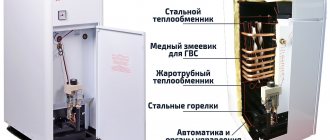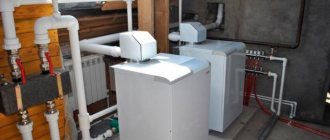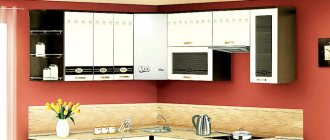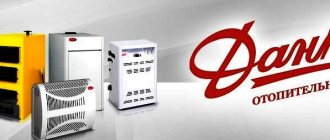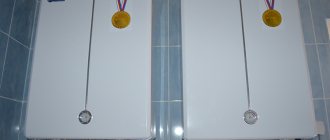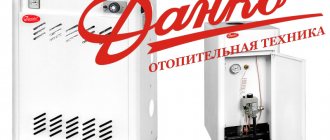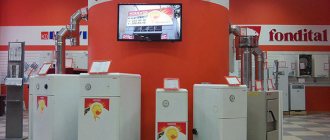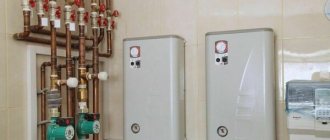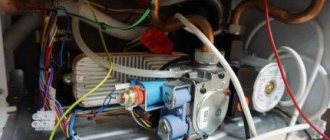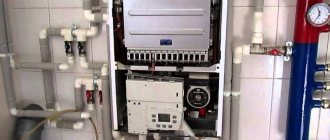The use of gas boilers in dachas and private homes is an economical way to heat a home. Gas has lower consumption and cost than electricity, and is much more convenient to deliver than solid fuels. The most common at the moment are floor-standing models, such as the Conord (only this type is produced). Wall-mounted ones, for example, “Danko” (this manufacturer produces both types of structures), are also firmly in use.
For your information! The main problem when operating gas boilers is proper starting.
Features of operation
Depending on the manufacturer and model, the device has a certain type of automation, which controls the entire combustion process, as well as its characteristics and, accordingly, operational features and certain rules when trying to ignite the boiler.
"Conord"
The main characteristics observed in the entire model range:
- The manufacturer produces boilers exclusively for floor-standing use, so any model from this company has a powerful casing of a fairly large size. It is protected by a layer of enamel, which prevents damage to the metal from moisture;
- since the manufacturer is domestic, the cost of its products is slightly lower than that of other brands;
- the efficiency of all boilers is on average 90%;
- the body and main structural components are made of steel sheets, the thickness of which is about 3 mm;
- Automation systems that provide control over gas combustion and operational safety require the boiler to be connected to a power supply.
The model range is quite wide, each model in it has various additional design elements. For example, there is an option for sale with warm water supply. It is equipped with automatic thermo-hydraulic type. For its operation, a constant stable connection to the network is required. The fuel supply is regulated by a thermostat: when the temperature sensor readings are required, gas access to the main burner is blocked.
For your information! High-quality automation ensures minimal deviations of the room temperature from the set one.
The productivity of the heating system is increased with a powerful burner when installed correctly. This is the only way to obtain a balanced mixture of gas and air. Good thermal insulation of the boiler, especially the chamber in which combustion occurs, also improves the quality of work. Low pressure will not interfere with the operation of this brand of unit. Thanks to all this, Conord allows you to warm up even in the most severe frosts.
Boilers of this brand also have a good multi-level security system:
- smoke exhaust sensor. It turns off the gas if there is no traction. It also does not allow the burner to be interrupted during strong gusts of wind, during which air moves in the opposite direction (“reverse draft”);
- temperature sensors. Shut off the gas when the temperature approaches the set limit;
- flame sensor. Interrupts the gas supply if there is no fire on the burner.
To know what other design and operation features there are, you need to be able to decipher the markings of a given brand. For example, KSts-GV-12 means that:
- this is a boiler (letter K);
- made of steel ©;
- cylindrical combustion chamber (letter C);
- the fuel for it is gas (this can be identified by the next letter G);
- “HW” means the presence of hot water supply;
- The numbers at the end indicate the maximum power output.
Important! The required heating power is calculated based on the amount of area. So, 1 kW of power is enough to maintain the desired temperature in a room with an area of 10 m², while the height should not be more than 2.5 m.
"Danko"
This foreign manufacturer has already gained popularity in European countries and is gradually moving to Russia. A relatively low price in combination with quality, good efficiency and aesthetics create good advertising for it. Another advantage is the production of wall-mounted and even floor-standing models that have modest dimensions. This makes Danko an indispensable assistant in small rooms (bathrooms, miniature kitchens). It will not steal precious space and will fit into almost any interior.
For Russian users there are a number of special advantages of this manufacturer over others:
- despite the fact that the units are not produced in the Russian Federation, they are perfectly suited for use with Russian pipes and batteries (even old cast iron radiators do not need to be replaced);
- the boiler will not have any problems when working with Russian gas;
- is not afraid of the harsh climate of Russia, it can be launched even in severe frosts;
- the boiler operates silently, which makes it indispensable in residential buildings with poor sound insulation;
- "Danko" can be used in systems where water circulation is not forced. That is, this boiler does not require a pump, which makes the heating system autonomous in relation to the electrical grid.
Danko heating systems have only one drawback in all models that need to be hung on the wall - horizontal chimneys are installed. They are quite vulnerable to strong wind gusts. Also, Danko wall-mounted modifications require more attention and care (especially frequent and thorough cleaning) with less power.
For your information! Due to the higher noise level, floor-mounted ones have to be installed in special rooms or corridors. But they are not so whimsical.
Installation
The thermal power of the unit must be selected according to the design for heating the house in order to ensure a sanitary thermal regime in the premises.
The lowest ambient temperature during operation is not lower than 5 C. When installing the boiler, the circulation speed of the centrifugal pump and the total volume of coolant in the network must be taken into account.
Basic provisions when installing a Danko boiler:
- Before installing the unit, a heat-resistant horizontal foundation is made. The walls are shielded with heat-resistant materials, the gap between the wall and the boiler is left at least 250 mm. The insulating layer should extend beyond the dimensions of the housing by 150 mm.
- In front of the front working wall of the device, free passage is at least 100 cm.
- It is forbidden to wall up the base of the unit into the floor, since the process of air intake into the combustion chamber will be disrupted.
- The boiler unit is placed below the level of the batteries for efficient coolant circulation within the heating circuit.
- The expansion tank is installed at the highest point of the heating network, mainly in a heated place.
- The unit is installed with a chimney more than 5 m from the level of the chimney, which is located in the boiler.
- The height of the pipe above the roof is set above the level of wind pressure, and not less than 50 cm above the roof ridge.
- The main smoke exhaust duct must be located vertically, have smooth internal surfaces, without turns or kinks.
- The design of the chimney must ensure that the temperature of the flue gases at the outlet of the boiler unit is greater than the dew point temperature.
- The connection between the gas pipe of the unit and the chimney is made with a zinc or non-corrosive pipe.
- The unit must be installed and maintained exclusively in rooms with stable supply and exhaust ventilation
- The boiler is connected to the system using easily removable connections: couplings, union nuts or flanges and cannot be accompanied by high pipe tension.
- Sections of heating pipes operating with natural circulation are made with a slope of 10 mm per 1 m in the direction of the battery to collect air and remove it when the system is filled with water.
- The connection of gas appliances to the boiler is carried out by representatives of Gorgaz.
Basic inclusion rules
Correct activation of the device must first of all comply with safety regulations. They are the same for both Danko and Conord:
- children cannot be trusted to turn on the boiler;
- It is prohibited to ignite devices whose automation does not work or does not work correctly;
- if you suspect a leak, do not try to ignite the unit or check the leak location with fire;
- You cannot light the burner without draft in the chimney;
- it is forbidden to turn on the heating without water inside the system;
- When igniting and subsequent operation of the boiler, it is prohibited to keep flammable objects nearby;
- The water temperature in the system during operation should not be higher than 90°C.
How to turn on a gas boiler
The main differences in switching methods depend not on the design of the boilers themselves, but on the type of automation that is installed in them.
For your information! That is, even different models from different manufacturers can turn on in the same way if they have the same automation system.
Danko boiler: how to turn it on and off correctly
Basically, the instructions on how to turn on the Danko gas boiler boil down to the following algorithm:
- Check that the boiler is turned off (the thermostat knob should indicate ignition).
- Next you need to open the tap in front of the boiler.
- The ignition button must be pressed and held in this position for a while.
- With your other hand you need to press the ignition button several times (until the gas in the burner ignites).
- After ignition, the ignition button must be held for about 10 seconds.
- After this, you need to make sure that the burner is still burning.
- Make adjustments by turning the thermostat knob.
Important! If the burner suddenly goes out, then you need to repeat attempts to ignite the boiler after 3 minutes. or more.
Switching off is done by turning the thermostat knob and closing the tap in front of the boiler.
Turning on the Conord boiler
You can ignite the gas in the burner of this boiler using a semi-automatic method. How to do it:
- The regulator should be in the extreme position.
- Then you need to push the wheel down for a period of 5 to 6 seconds. At this time, gas flow into the chamber begins.
- By pressing the ignition button, a piezoelectric element is activated, which ignites the mixture.
- After the fire appears, you need to hold the wheel in the down position for a little longer (about 10 seconds).
- Next you need to start setting the desired temperature.
Price range
Conord boilers belong to the group of inexpensive equipment. Prices for units fall within the range of 11-47 thousand rubles, which is significantly cheaper than imported units.
A big bonus is the energy independence of the boilers, which frees the user from the need to purchase a voltage stabilizer as unnecessary.
IMPORTANT!
Purchasing water filters is necessary, especially for residents of regions with hard water. You also need to enter into a guarantee agreement, which you will also have to pay.
Care tips and advice
Proper maintenance of the boiler, performed regularly, will help keep it in working condition for a long time and avoid various accidents and accidents. Otherwise, the unit may break even in the first year of operation. Performing several operations will prevent this from happening:
- even during normal operation of the boiler, you need to contact one of the organizations carrying out work in this area, so that a technician inspects the device for gas and water leaks, the condition of the sensors and chimney, and, if necessary, carries out repair work;
- You should always monitor the water pressure inside or at the outlet of the system. If it drops below 0.8 bar, then water needs to be added;
- The addition of water to the system is usually carried out directly through the boiler, where there is a special tap. In this case, the pressure of the added water must be greater than the pressure of water from the boiler. The supplemented water should only be cold (up to 35°C).
For your information! To spend winter evenings warm and comfortable, you need to properly care for your boiler and also know how to light it.
Depending on the model and manufacturer, this process will be slightly different due to differences in design. This can be clarified in the instructions supplied with the device.
Autonomous heating systems for private houses are gradually becoming no less common than centralized networks.
This is caused by the desire to save on paying for network resources, the unavailability of connecting to a central heating center in remote cottage villages, or other reasons.
There are a large number of samples of heating devices on the market, of which gas boilers are unanimously recognized as the most effective.
They are produced by all well-known companies in Europe and Southeast Asia.
Manufacturers from the countries of the former USSR are not lagging behind, their products are able to successfully compete with European models.
Circulation pump
Air often accumulates in it, and its blades sometimes seem to get stuck (the boiler will display a corresponding error).
It is recommended to rotate the shaft manually before starting.
To do this, you need to remove the front panel of the housing, unscrew the central bolt on the pump and use a straight-bladed screwdriver to turn the shaft in the direction indicated by the arrow.
An air vent is installed above the pump. You need to pull the bright lid up and let the air escape.
Floor-standing boilers are usually more powerful than wall-mounted ones. If you need to heat a large room, it is better to choose this option. Floor-mounted gas boilers for home heating – overview of design options and models.
Read about the installation features of combined heating boilers in the following material.
Conclusion
At first, the system may make gurgling sounds, all because during startup it is impossible to bleed air down to the last atom. It will gradually be removed through the expansion tank valve. Periodically check the pressure on the pressure gauge - it should be within the operating range. Temperature adjustment and other boiler settings are described in the instructions for each model.
Danko gas boilers
The owner of the Danko brand is Agroresurs PJSC from Ukraine. The company simultaneously creates several types of heating equipment, the popularity and demand for which among users is steadily increasing.
The production facilities where Danko boilers are manufactured are located in the Ukrainian city of Rivne.
The company set as its goal to create a reliable, durable and durable gas boiler that has all the necessary functionality combined with a low price.
Ukrainian engineers were able to cope with this task, implementing a wide range of affordable and efficient gas units. It was possible to achieve high productivity, reliability, and eliminate unnecessary or unclaimed components and parts.
In parallel with high efficiency, the developers were able to reduce prices, which made Danko units available to a wide range of users.
Danko gas boilers are produced in various structural types, which can be divided into groups according to general characteristics.
By installation type:
- Floor-standing. Installed on a special non-flammable stand or directly on the floor.
- Wall-mounted. Wall-mounted installation, on load-bearing walls or special metal support structures (Ramps).
- Parapet. These are non-volatile units with a hinged installation type. They differ from wall-mounted ones in some features of connection to the chimney and the need to ensure a slope of the heating system pipelines, ensuring natural circulation of the coolant.
By feature set:
- Single-circuit. Designed exclusively for heating the coolant and supplying it to the heating circuit.
- Dual-circuit. Capable of simultaneously heating the coolant and preparing hot water for domestic needs.
By type of combustion chamber:
- Open (atmospheric) . Air intake for normal combustion is carried out directly from the room in which the boiler is installed. Smoke is removed naturally using a stove-type draft.
- Closed (turbocharged) . Air intake and smoke removal are performed using a turbocharger fan.
In addition, there are models with a steel or cast iron heat exchanger.
Also, in some series of units, different types of automatic control of the operation of the gas unit can be used:
- Kare (Poland) . Manufactured specifically for installation in Danko boilers. The kit includes a reducer, valves, a thermostat and pressure, draft and boiling sensors.
- Honeywell (USA) . High-quality electromechanical gas supply control units, which are installed in the most advanced models of gas boilers.
- Sit (Italy) . Automatic control units for gas equipment, used in most European models of gas boilers.
The range of Danko boilers is wide; the user has the opportunity to choose the best option for any area and operating conditions.
Types
The Danko range of gas boilers includes 22 modifications, differing in design and functionality. The units are available in single- and double-circuit versions. Single-circuit AOGV models are designed for heating and do not have the function of heating water for a hot water supply system. More powerful dual-circuit appliances provide the consumer not only with heating, but also with hot water. In such devices there are two circuits independent from each other, in each of which the desired temperature is set.
Danko boilers are equipped with two types of combustion chambers: open and closed. In the first, the air required to maintain combustion is taken from the room in which the boiler is installed. While in closed-type chambers the flow of oxygen is carried out through a coaxial chimney pipe, through which exhaust gases are removed. Closed cells are safer. They do not burn oxygen in the home and make the gas combustion process completely isolated from the room.
Based on the installation method, models are classified into three types.
- Mounted options are considered the lowest power, the power of which can be 8, 10, 12 and 15 kW. The devices are equipped with both copper and steel heat exchangers, have single- and double-circuit designs and are capable of heating a room of up to 210 square meters. The advantage of wall-mounted units is their light weight, small dimensions, electric ignition system and protection against freezing of the coolant. In addition, some models are equipped with a self-diagnosis function, which allows you to quickly and accurately determine the malfunction and repair the breakdown. The average consumption of wall-mounted units is 2.5 cubic meters of gas per hour, and the membrane tank can hold up to 6 liters.
- Floor-standing units with an open-type combustion chamber are distinguished by greater power, which for serious boilers reaches from 20 to 24 kW. The models are equipped with pumps that support forced circulation of the coolant, a steel or cast iron heat exchanger, and a control system that allows you to regulate draft and flame levels, as well as the moment of water boiling. All floor-standing units are equipped with a gas shut-off system in case of insufficient draft or flame extinction, have a wide range of models and are capable of heating a room of up to 360 square meters. The most powerful models with a cast iron heat exchanger are capable of developing power up to 50 kW.
Series and models
Floor standing boilers are presented in the following series:
- CP or VSR - single- and double-circuit models with a power of 8, 10, 12, 15, 18, 20 and 24 kW. Equipped with a 3 mm thick steel heat exchanger.
- SN and VSN are floor-standing units with increased power from 30 to 48 kW. Steel heat exchanger.
- Rivnetherm. A series of floor-standing boilers with increased power for heating large areas. It is represented by single- and double-circuit models with a power from 30 to 96 kW, capable of serving premises up to 900 m2. Steel heat exchanger.
Series of wall-mounted boilers:
- US and UVS are single- and double-circuit boilers with a capacity of 7, 10, 12.5, 15.5, 18 kW. Equipped with a 3 mm steel heat exchanger.
In addition, there is a separate series of floor-standing boilers with a cast iron heat exchanger, the power of the models is 16-50 kW. They have an enlarged body due to larger parts.
Specifications
Let's look at the characteristics of gas boilers:
| Parameter | Meaning |
| Boiler type | Gas heating |
| Fuel type | Natural gas with the possibility of conversion to liquefied gas |
| Feature Set | Heating and hot water supply |
| Combustion chamber type | Atmospheric or turbocharged |
| Average gas consumption | 1.9-2.7 m 3 / h |
| Efficiency | 92 % |
| Heating area | 70-900 m |
| Energy consumption | Non-volatile or single-phase 220 V 50 Hz |
Gas heating in a wooden house: rules and regulations
Heating a wooden house with gas has a fairly large number of advantages. However, when using this type of heating of a wooden room, special attention should be paid to fire regulations, since if used incorrectly, this can lead to tragic consequences.
Main characteristics
Important elements of the house that need to be taken into account when choosing such heating are:
- Floor material. As a rule, the floor is made of boards, plywood or OSB, which are laid over the foundation beams. Such a base is quite movable, which eliminates the possibility of installing a water-based underfloor heating system, because it must be mounted with a screed.
- Insulation of walls and windows. Basically, such surfaces are made of logs or beams, which have a high level of thermal insulation. The coldest place is considered to be the opening, both window and door. That is why heating of a wooden house should be centralized in such places.
It is also important to note that a large amount of heat is also lost through the roofing areas, so the surface of the floor and attic should also be carefully insulated.
Moreover, a material such as wood has good flexibility, which allows the entire system of pipes and air vents to be installed without much interference.
Types of structures
Gas boiler
This design consists of a centralized boiler that heats the heating compartment. In this case, the gas is liquefied and distributed through the pipes, thereby releasing thermal energy. The radiators themselves, being heated to a safe temperature level of 80 degrees, heat the room. The safest solution in this case would be to use main gas, since it is located in a special room - the boiler room - and does not need to be carried through all rooms of the house.
However, heating a wooden house with gas using a gas boiler has some features that must be taken into account:
- It is necessary to choose a boiler that operates on the convection principle, since condensing boilers, although they are less expensive, require a low temperature of the pipeline system, which cannot be done while maintaining the optimal level of heat. The heated floor system can operate at low temperatures, but it is difficult to install it in wooden houses (for more details: “Warm floors in a wooden house are the key to comfort”).
- The heating system should, as a rule, be single-pipe, barrack-type. The main pipe runs along the entire perimeter of the house, and heating radiators are cut in the direction of this pipe. All this is suitable for a convection boiler, with heating of 60 degrees and above.
- You can purchase boilers with electronic ignition. That is, they do not need to constantly maintain the combustion mode of the main burning part, which in turn increases the level of safety. In case of frequent power outages, you can simply install an uninterruptible power supply system
Advantages and disadvantages
The advantages of Danko gas boilers include:
- The production process uses advanced technological methods and developments.
- High quality components and parts.
- Reliability, long service life of the boiler.
- Economical fuel consumption.
- Quiet operation.
- Relatively low price.
- Compact, attractive appearance.
The disadvantages of Danko boilers are:
- The need for periodic maintenance and chimney cleaning.
- In atmospheric models, cases of flame extinction due to external factors are noted.
- Wall-mounted models are limited in power, and floor-mounted ones have increased noise during operation.
The disadvantages of Danko boilers are completely surmountable and can be attributed to design features.
Pressure testing and washing
Pressure testing of the system is not the most necessary preparatory stage, but it is desirable, since it will show defects and leaks in advance, if any.
Pressure testing is not always done due to the lack of a special pump and the reluctance to call a team, but if the heating fails in the midst of cold weather, the costs can be much higher!
It is especially important to check a new system and one that, on the contrary, has been in use for several years.
The cost of crimping in construction companies is from 3,000 rubles. Additionally, they may charge a fee for visiting the site (about 2 thousand rubles). By the way, a manual pressure testing pump will cost 4.5 – 6 thousand rubles.
Device
The Danko gas boiler is designed according to general methods adopted by all European companies . The main component of the boiler is a gas burner and a heat exchanger, combined into a single system .
Water enters the primary heat exchanger, heats up and passes into the secondary plate heat exchanger, which prepares hot water. After this, the coolant enters the three-way valve, where it finally receives the temperature set by the mode.
To do this, it is mixed with the colder return flow in the required proportion. Then the coolant is discharged into the heating circuit for the next round of circulation.
Final stage: connection revision
After all the stages of connecting a gas boiler have been completed, there is no rush to start it up. It is necessary to check the correctness of all stages of installation work. You can start operating the gas unit only after you are 100% sure that everything has been done flawlessly.
Be sure to check the connection of the water circuit and identify possible leaks. There is nothing complicated about this, since water leakage appears immediately. But you can’t just see the shortcomings associated with the gas pipeline. Proceed as follows: moisten the gas pipe generously with soapy water and watch for the appearance of air bubbles. If everything is in order, there will be no bubbles.
The first test run of the gas unit is recommended to be carried out under the supervision of specialists from the gas supply organization. To do this yourself, you need to have special permission. However, only professionals can accurately determine whether a gas boiler is connected correctly or not. Experts will advise you on how to connect heating to a gas boiler and help you avoid possible mistakes. You shouldn’t ignore their advice, since we are talking about people’s health and lives.
Operation and setup
Operating requirements are detailed in the user manual, which must be carefully read before using the unit.
The key to successful operation is competent and high-quality installation. Floor-standing models are installed on a non-combustible substrate (a layer of asbestos, on top of which a metal sheet is laid), and wall-mounted boilers are hung on brackets secured with anchor bolts.
Only strong load-bearing walls are suitable for installation; temporary and plasterboard partitions for hanging are prohibited.
Boiler tuning consists of adjusting factory settings designed to increase efficiency and stability of operation.
The boiler must be adjusted by a specialist from the warranty workshop . Doing the work yourself can damage the unit.
In addition, unauthorized work with gas equipment is an offense and can be punished within the competence of the gas service.
About the company and boiler products
Danko is a company that positions itself as a manufacturer of high-quality boilers at an affordable price. Since cast iron is considered a reliable and durable material, the developers from Ukraine decided to place all the elements and components made using modern technologies in a cast iron body. The result is a Danko gas boiler with a long service life. When properly operated, the unit will effectively provide heat to a room for 25 years, which is ten years more than its steel counterparts.
Basic faults
The most common malfunctions of Danko gas boilers, experts and ordinary users include problems with the burner and gas consumption.
Cases of flame attenuation (failure), characteristic of boilers with an atmospheric burner, are often noted. In addition, the injectors often become clogged with soot, soot and other combustion products. Excessive gas consumption occurs due to the appearance of a layer of scale in the primary heat exchanger.
It acts as a thermal insulator, reducing the efficiency of heat transfer. The user notices that the coolant temperature has dropped and increases the flame burning mode.
This causes the heating of the outer surface of the heat exchanger to become stronger, which causes rapid failure of the unit.
The solution to the problem is the use of softening water filters (as a preventive measure) and periodic washing of the heat exchanger, for which you need to invite a technician from the service center.
What problems happen?
The simplicity of Danko's design allows its owners to carry out minor repair work on their own. One of the most common problems is the burner blowing out. This is especially common in strong winds. Usually no fault is found, the wind is the culprit of the problem, but it is better to check the following points:
- Is there a check valve installed in the chimney? If not, then there will be no reverse thrust, which is why attenuation occurs.
- If the chimney is installed incorrectly, it becomes clogged with soot and other combustion products - it needs to be cleaned.
It happens that before the attenuation, extraneous noise is heard or increased fuel consumption is observed - this may indicate a failure of the controller. The task is to repair or replace a spare part.
Another common problem is the pilot light going out. It goes out due to the activation of the thermostat, which shuts off the gas supply if the burner does not heat up to the desired temperature.
Why does it go out?
The first and most simple reason for attenuation is a stop in the gas supply. To resolve the issue, you need to close the gas tap and call the appropriate service for clarification . There are other possible reasons.
Self-extinguishing of the Danko boiler flame is often observed in models with an open combustion chamber. It is usually caused by a strong gust of wind or a draft that blows off the burner flame when doors or windows are suddenly opened.
To solve the problem, it is necessary to establish an air exchange mode that eliminates the possibility of reverse draft and drafts.
The chimney should be located on the leeward side of the roof so that strong gusts do not create the possibility of a flame breaking out.
Another possible reason is a breakdown of the regulator, gas valve or other parts of the gas equipment. In this case, you should turn off the boiler, turn off the gas supply and call a technician from the service center.
Owner reviews
To obtain more balanced information, it is useful to consider the opinions of the other side - users and owners of Danko boilers.
They have no material or reputational interest in concealing or distorting facts, therefore all information received from them is doubly valuable:
- I have been using a Danko boiler for about a year now. It worked fine through the winter, no failures or problems arose. Gas is consumed quite economically, operating the boiler is very simple, everything is clear and without instructions. My boiler has a floor-standing design, but does not take up extra space. A good unit for a very reasonable price, I recommend it to everyone.
- I have a Danko floor-standing double-circuit boiler with an atmospheric combustion chamber. He worked for me for two years. In general, it copes with its task, the house is warm and there is hot water. But there are also some complaints - the gas consumption is too high and the burner often goes out. I think that my boiler justifies its cost, but it could have been done better.
- When the old boiler became unusable, I chose the new Danko-18. It has already worked all winter, and I can definitely say that gas consumption has decreased by about a third compared to the old boiler. It works quite steadily, even though it has an open burner. I had the same old one, I got used to handling them - the main thing is not to create drafts, and my chimney was installed correctly, the wind does not blow. The controls are simple, the operating mode is maintained smoothly.
- For heating and supplying hot water, we bought a Danko wall-mounted double-circuit boiler. The house is small, it was possible to get a cheaper boiler, but the seller recommended this one. When they installed it and started using it, it seemed like they had overpaid. However, after a couple of months we realized that the boiler was normal and fully operational. It doesn't consume much gas and is quite economical.
- I myself am involved in the construction and improvement of houses. For heating I always recommend that people buy Danko boilers. I have one like this in my house. It is economical, reliable, does not consume excess fuel, is easy to operate, and is compact. It performs all its functions as expected, and there is nothing superfluous in it.
- A good, reliable and inexpensive boiler. My friends have had Danko for several years now, I’ve seen enough of them and bought the same one myself. It works silently, the controls are simple and intuitive, without instructions. In terms of gas consumption, I have nothing to compare with, but my neighbors seem to be doing better than me. In general, I am satisfied and recommend it to everyone.
- I didn't know which boiler to choose. Imported ones are very expensive, so I bought a Ukrainian Danko boiler. It has already worked for me for 1.5 seasons. It consumes quite a bit of gas, so far there have been no problems in operation. Sometimes the burner goes out on its own, but this is infrequent; the master said that drafts or gusts of wind outside are to blame.
Here you will learn:
Heating equipment from the Danko brand is in definite demand among domestic consumers. Its key feature is simplicity, which ensures a long service life and reliability of the manufactured equipment. The Danko boiler will be an excellent choice for heating premises for any purpose - most often they are residential buildings. In this review, we will look at the most interesting models and introduce you to user reviews.
Possible problems with the boiler
Frequent questions from users regarding malfunctions of this Ukrainian equipment include the following:
- Why does the Danko gas boiler blow out?
- Why does the unit go out?
- What causes high gas consumption?
If we summarize the practical experience of the owners and take into account the opinions of experts, we can make a small list of possible causes of these problems:
- Gas line failures (gas is supplied unevenly).
- Problems with the chimney (most likely, soot and soot have accumulated on the inner walls, which impede the proper removal of combustion products).
- Possible damage to any structural elements. For example, a malfunction of the ventilation device, which does not supply air flow to the combustion chamber.
- Electrical supply problems that directly affect the operation of boiler equipment. In other words, interruptions in the functioning of the circulation pump or blower fan, which affects poor heating of the room.
- There is no valve in the smoke structure, this does not allow the reverse draft to work normally, as a result - the system blows out and attenuates.
Experts recommend thoroughly cleaning the chimney of deposits.
How to light a Danko gas boiler?
Light the boiler using a semi-automatic method in stages:
- The mechanical regulator is brought to its extreme position.
- Press the wheel down for 5-6 seconds. Gas is supplied to the burner.
- Ignition occurs using a piezoelectric element.
- After igniting the ignition burner device, continue to hold the regulator in the down position for approximately 5-10 seconds. If, after lowering the wheel, the igniter goes out, the procedure begins again. The burner has a sensor that records the temperature on the body. If the burner device is not heated sufficiently, the gas supply valve is not opened.
A little about production
Danko gas boilers are almost entirely produced using imported equipment - it is supplied from Japan, Finland, Denmark and other countries. This allowed us to improve the quality of our products and make them more reliable and durable. The production involves modern assembly and metalworking machines, powder coating equipment, cutting equipment and much more. Most operations are automated, but some are performed manually.
Danko boilers are presented in two categories:
- Floor-standing models – a wide range of equipment with power from 8 to 96 kW;
- Parapet (wall-mounted) models - wall-mounted models with closed combustion chambers with a power of 7 to 15 kW.
Interesting and popular models
We have compiled for you detailed descriptions of Danko brand boilers and supplemented them with basic technical characteristics. This information will help you make the right choice and buy the most suitable equipment.
Danko 12
Before us is a typical floor-standing single-circuit boiler with a power of 12 kW, made according to a scheme with an open combustion chamber. The heat exchanger in this model is made of steel and natural gas is used as fuel. The device uses a mechanical heating system, which makes the boiler suitable for use in houses without electrification. The maximum pressure in the heating circuit should not exceed 1.5 bar at temperatures from +35 to +90 degrees.
The Danko 12 gas boiler is optimal for heating households up to 100 square meters. m. It will be an inexpensive solution for a country house or cottage, without burdening buyers with large expenses. Gas consumption when operating at maximum power does not exceed 1.4 cubic meters. m/hour. The estimated cost of the unit in online stores is about 20.5 thousand rubles.
Danko 10UVS
This gas boiler will solve the problem of heating and preparing hot water for supply to taps. It is dual-circuit, but differs from most modern wall-mounted models in its mechanical control. The power of the device is 10 kW, the maximum heated area is 100 sq. m. Efficiency is up to 90%, natural gas consumption is up to 1.2 cubic meters. m/hour. The device can operate on liquefied gas with a flow rate of 0.43 kg/hour.
The Danko 10UVS boiler is equipped with a minimum of controls and is housed in a neat rectangular body. The device is mounted on a wall, behind which the supplied chimney is routed. It is no more difficult to control than any other heating unit - just light the igniter and set the desired heating level. Detailed startup instructions are supplied with each boiler.
Danko 24VSR
One of the most popular models with a power of 26.3 kW. The boiler can be used to heat residential buildings with an area of up to 260 square meters. m. But if we take into account a reserve of 20%, the maximum area will be about 210 sq. m. m. The device is dual-circuit; it not only generates heat, but also supplies hot water. Being built according to a non-volatile scheme, it does not require connection to the mains and operates autonomously.
If necessary, the Danko 24VSR boiler can be converted to work with liquefied gas. For this purpose, kits from the same manufacturer are used. If the flow rate with the main gas pipeline is 2.8 cubic meters. m/hour, then with liquefied - 1.03 kg/hour. Heating circuit parameters – pressure up to 2 bar, temperature from +40 to +90 degrees. I am pleased with the performance of the DHW circuit, which is 9.85 l/min.
Danko 15 SR
Before us is another gas boiler with a mechanical control system. The desire to use “mechanics” is the desire of the manufacturer to provide heat to residential buildings located in populated areas where power is often cut off - believe me, there are more than enough such places in Russia, despite the widespread modernization of electrical networks. The power of the model is 15 kW, the heated area is up to 150 sq. m. m. The heat exchanger of the unit is made of steel, the maximum pressure in the circuit should not exceed 1.5 bar.
The Danko 15 CP boiler can operate on main and liquefied gas. The model turned out to be economical - consumption at maximum power is 1.7 cubic meters/hour when powered from the main line or 0.65 kg/hour when powered from a cylinder. The bottled gas pressure must not exceed 35.28 mbar. To connect it to the boiler, you must use equipment kits from the Danko brand.
How to choose?
Before you start choosing a model, you need to determine the functional purpose of the boiler and its power. Double-circuit units should be selected if you plan to equip not only heating, but also hot water supply
Particular attention should be paid to the heat transfer coefficient of the device, which is especially important when calculating the power of the heating system in regions with cold climates. Convection models have the highest efficiency. This type of design is presented in many Danko floor-standing appliances and is recommended for use in northern regions
This type of design is presented in many Danko floor-standing appliances and is recommended for use in northern regions.
Judging by the reviews of the owners, it was convection boilers that showed their best performance when heating a private home in harsh conditions. In addition, floor-standing devices are non-volatile. In the event of a power outage, they will not leave the house without heat. The most popular model among floor-standing appliances is the Danko 18BC model. The boiler has dimensions of 41x85x49.7 cm, weighs 81 kg and is designed to heat a room up to 170 m².
For heating country houses or when installing a heating system in southern and temperate latitudes, wall-mounted and parapet units are quite suitable. These devices can effectively warm a medium-sized room and provide residents with uninterrupted hot water supply. The disadvantage of such devices is the presence of electronic ignition, which does not allow the boiler to light in the absence of electricity.
Many models are equipped with frost protection, which is important when operating the device in conditions of temperature changes in the absence of owners, when it is not possible to force the device to turn on or off
When choosing equipment, you should also pay attention to fuel consumption. Single-circuit appliances consume significantly less gas than dual-circuit models
For example, a floor-mounted single-circuit unit of the Danko 8 brand, having a heat transfer coefficient of 92% and capable of effectively heating a room of 70 square meters, consumes only 0.9 cubic meters of gas per hour, while some double-circuit boilers consume 2.5 and more than cubic meters of fuel.
